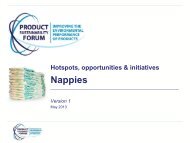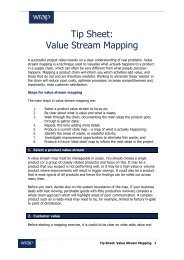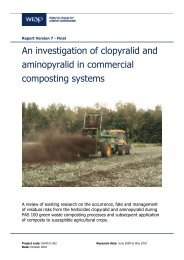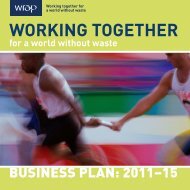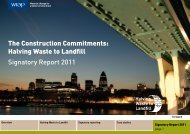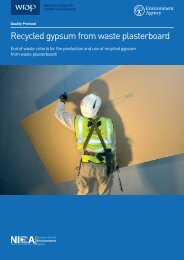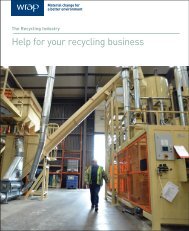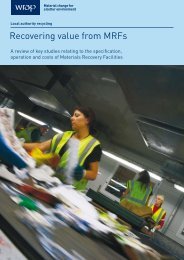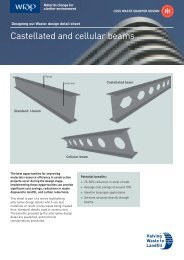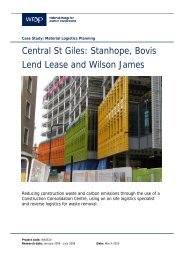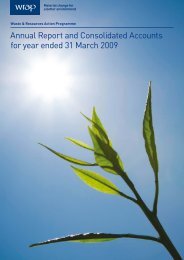Developing a Strategic Approach to Construction Waste
Developing a Strategic Approach to Construction Waste
Developing a Strategic Approach to Construction Waste
Create successful ePaper yourself
Turn your PDF publications into a flip-book with our unique Google optimized e-Paper software.
Restricted – CommercialAEA/ ED02414/Issue 1<strong>Developing</strong> A <strong>Strategic</strong> <strong>Approach</strong> <strong>to</strong> <strong>Construction</strong> <strong>Waste</strong>3.2 Supplementary Planning DocumentsThe following sub-section provides feedback from two councils who have developed SupplementaryPlanning Documents in order <strong>to</strong> relieve their waste disposal problems and aid waste minimization at asub-regional level.3.2.1 Bris<strong>to</strong>l City SPDBris<strong>to</strong>l introduced their Supplementary Planning Documents (SPD) in order <strong>to</strong> expand the definitionsof policy. However they are not enforced through legislation so are often ignored, but they doencourage developer and construction companies <strong>to</strong> plan ways of aiding waste minimisation in thefuture. North West Somerset <strong>Construction</strong> plan (C.2002) was brought in <strong>to</strong> encourage waste audits <strong>to</strong>be prepared and submitted before planning was granted. These would state how and where wastewould be disposed.Bris<strong>to</strong>l Council Planning dept feel there needs <strong>to</strong> be a <strong>Waste</strong> Minimisation Act that brings all legislationand regulations under one umbrella, tying in joint waste management plans and linking developmentplanning with construction operational aspects.3.2.2 Brigh<strong>to</strong>n and Hove SPDBrigh<strong>to</strong>n and Hove (B&H) set up a <strong>Construction</strong> <strong>Waste</strong> Supplementary planning document becausethey have run out of landfill space and other potential sites are in an Area of Outstanding NaturalBeauty (AONB) or are being slowed down by legal objections and judicial reviews.These documents were important because B&H council landfill 54% of their waste, so they now have<strong>to</strong> pay other landfill owners <strong>to</strong> take their waste. (the incineration plant is still making very slowprogress). B&H are also being forced <strong>to</strong> take a percentage of London’s waste as it a surroundingcouncil, however it is outside the 90max travel <strong>to</strong> site time set in the agreement (as it has nomo<strong>to</strong>rways <strong>to</strong> the current disposal sites).B&H have implemented policies/conditions early in their planning stages in order <strong>to</strong> be able <strong>to</strong>penalise those not adhering <strong>to</strong> their policies. i.e. every construction site needs <strong>to</strong> produce a SWMP forsites over 6 houses or 500m2 in size as a way of thinking ahead <strong>to</strong> construction phases, hencereducing waste. Currently 13% of construction materials leave the building site as waste. Of these,numerous sites mix their waste in one skip, hence meaning it has <strong>to</strong> be treated as hazardous waste,increasing the problems of final disposal and increasing the costs <strong>to</strong> the site (C.£500 for hazardousskip disposal and C.£100 for separated inert waste).B&H feel the EA need <strong>to</strong> have a public campaign raising awareness as <strong>to</strong> the benefits <strong>to</strong> theenvironment and C&D Company’s profit margins, but improving SWMPs and general planning ofwaste minimisation, separation of waste on site and disposal from construction sites. Likewise, betterdesign, s<strong>to</strong>rage on site and ordering will reduce the amount of s<strong>to</strong>ck s<strong>to</strong>len from sites, wasted due <strong>to</strong>being left on wet ground or not covered from the elements, all leading <strong>to</strong> reduced waste and largerprofit margins. Developers will also be able <strong>to</strong> pressurise architects <strong>to</strong> designing developments withwaste minimisation in mind i.e. employ Quantity surveyors and using metric systems i.e. buildingdesigns incorporating standard lengths of building equipment (timber, plasterboard etc)Most large sites B&H are aware of now employ Env. Manager on site, <strong>to</strong> ensure the site adheres <strong>to</strong> itsever tightening EU legislations. They "pay for themselves" by improving recycling, ensuring betters<strong>to</strong>rage of s<strong>to</strong>ck and waste separation (hazardous from inert) leading <strong>to</strong> the reduction of costs <strong>to</strong>developers. There is a possibility that staff can even be awarded by bonuses on a site by site basis ifthey adhere <strong>to</strong> these changes-hopefully leading <strong>to</strong> a change in culture.24 AEA Energy & Environment



